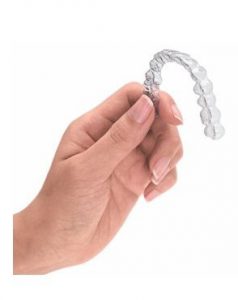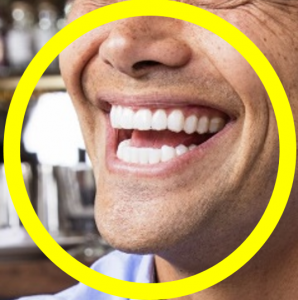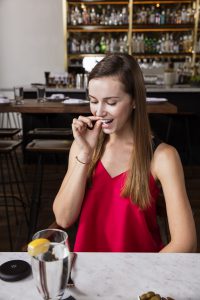There are now more options than ever before to straighten your teeth. Many adults are choosing to use clear aligners instead of metal brackets and wires to achieve their smile goals. Often, we hear that people would choose leaving their teeth in a crooked state rather than wearing traditional braces.
Clear aligners are a wonderful, “invisible” option for straightening teeth, and it is important to understand their difference from traditional braces.
What is Invisalign? 
Invisalign is a specific manufacturer of clear orthodontic aligners. Many dentists choose Invisalign because it has the longest, most successful history in orthodontic treatment with clear aligners. Invisalign offers a high quality aligner material with proven effectiveness through millions of aligners in its 20+ year history.
As with all clear aligners, Invisalign works by putting gentle pressure on the teeth to move them into a specifically prescribed position. Each aligner moves the teeth a very small amount often in increments of tenths of a millimeter. Over the course of treatment, each patient wears a series of aligners to accomplish the complete movement of the teeth into their final desired position. The more movement you need, the more aligners your treatment will have.
What are the Advantages of Invisalign over Traditional Braces?
 The biggest advantage, which is also the reason most people choose Invisalign, is its almost invisible appearance. The aligner material from Invisalign is superior in fit and transparency to other brands of clear aligners. Most people cannot tell that you have anything on your teeth.
The biggest advantage, which is also the reason most people choose Invisalign, is its almost invisible appearance. The aligner material from Invisalign is superior in fit and transparency to other brands of clear aligners. Most people cannot tell that you have anything on your teeth.
Another important advantage for adults is the fact that Invisalign aligners are removable. Whether you have a presentation at work or a wedding speech, you can remove the aligners for important meetings or events. There is no risk of embarrassing food caught in the teeth because you remove the aligners while you eat.
Invisalign allows you to keep your teeth as clean as possible while you straighten them. Unlike traditional braces, which attract quite a lot of plaque buildup and are difficult to clean around, you simply remove your aligners to brush and floss normally. This means that straightening your teeth with Invisalign has a lower risk for cavities and gum disease than traditional braces.
Because clear aligners cover your teeth, they are multifunctional! They protect the enamel surfaces from any abrasive forces of teeth grinding because they separate the teeth while you sleep. Aligners can also function as carriers for teeth whitening gel. This means that you cannot only straighten your teeth; you can also whiten them while you straighten.
What are the Limitations of Invisalign? 
It sounds perfect, doesn’t it? It almost is! There are just a few limitations to Invisalign that are important to understand before you embark on clear aligners.
Being removable is both good and bad. We already discussed the advantages of being able to take the aligners out when needed. Unfortunately, having the option to take them out could lead to a patient not wearing them for the required treatment time. With traditional braces, the patient cannot remove them, so he or she has no responsibility in the tooth movement.
In order for Invisalign aligners to accomplish the prescribed amounts of tooth movement, they must be on the teeth for a minimum of 22 hours each day. When the pressure of tooth movement is uncomfortable, it can be very tempting to simply take the aligners out. When you take them out for lunch with your friends, you could forget to put them back in. You know yourself. If there is a chance that you might be less than compliant with your responsibility to wear them 22 hours a day, Invisalign might not be the best option. When you do not wear them, the teeth do not move.
Another important limitation to understand is that there are certain types of tooth movement not easily accomplished with clear aligners. For example, your dentist cannot correct large problems with the bite or relationship between the upper and lower jaws with clear aligners. Your dentist knows the limitations of clear aligners and will not embark on treatment that will not accomplish your goals. If necessary, we may refer you to see an orthodontist to discuss traditional braces so that you get the final results you want.
Interested in Invisalign?
Call today to schedule a consultation with our doctors. We love creating beautiful smiles with clear aligners!


Comments are closed.